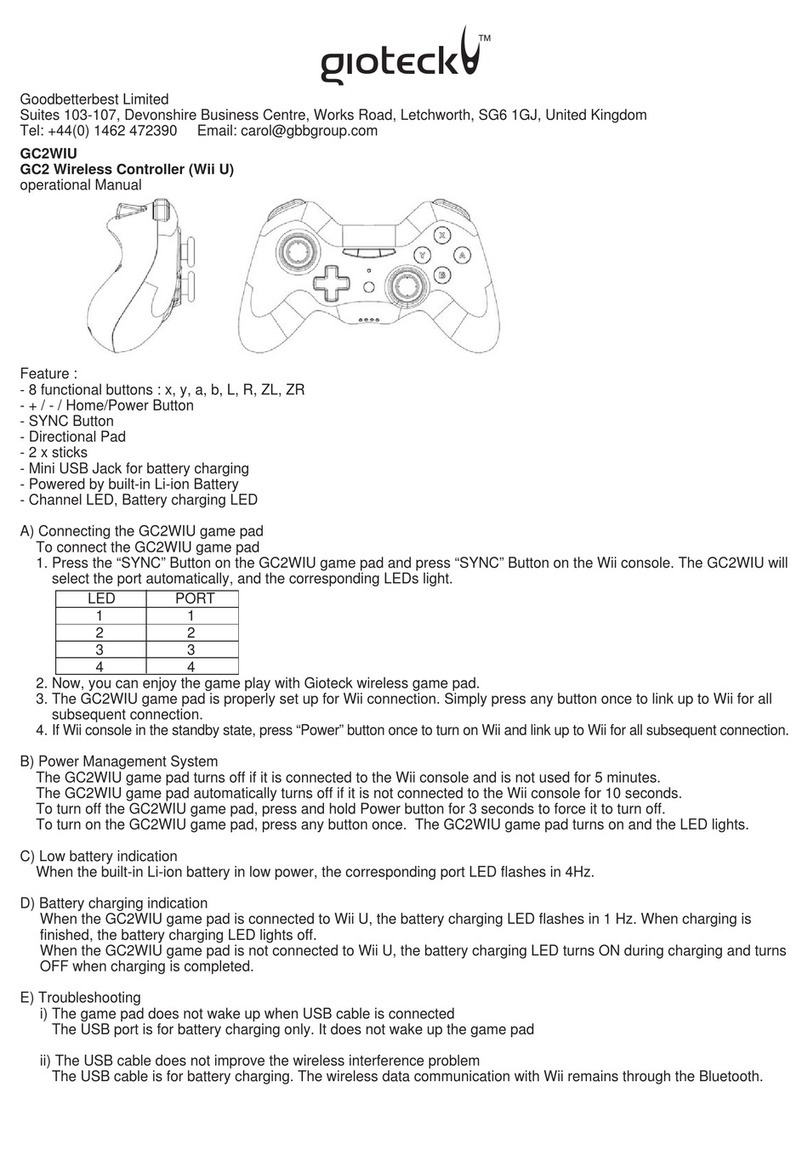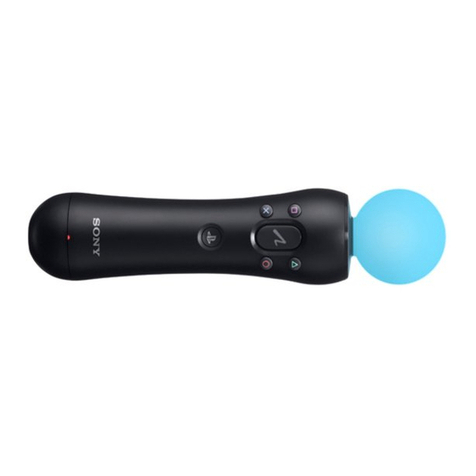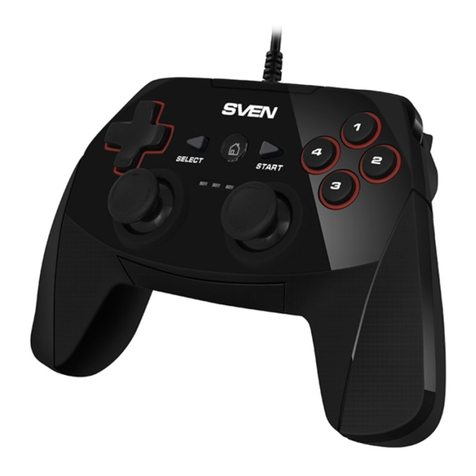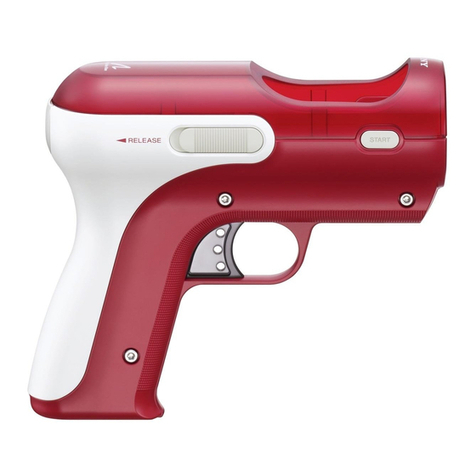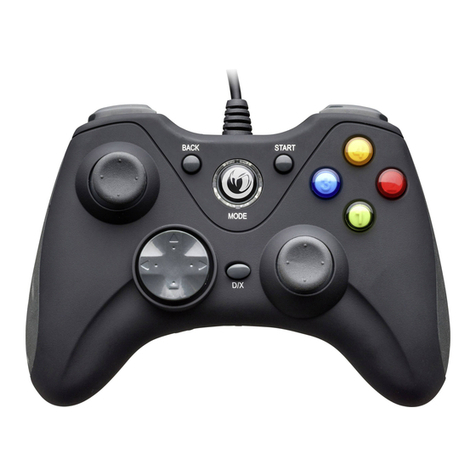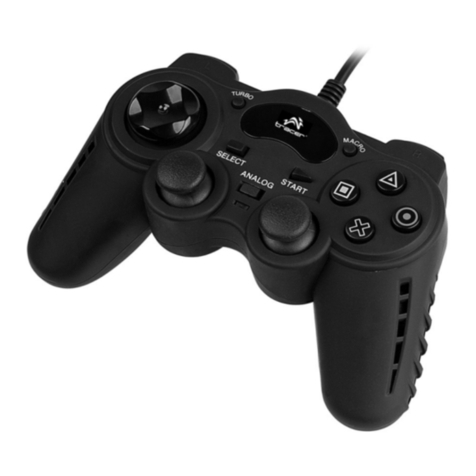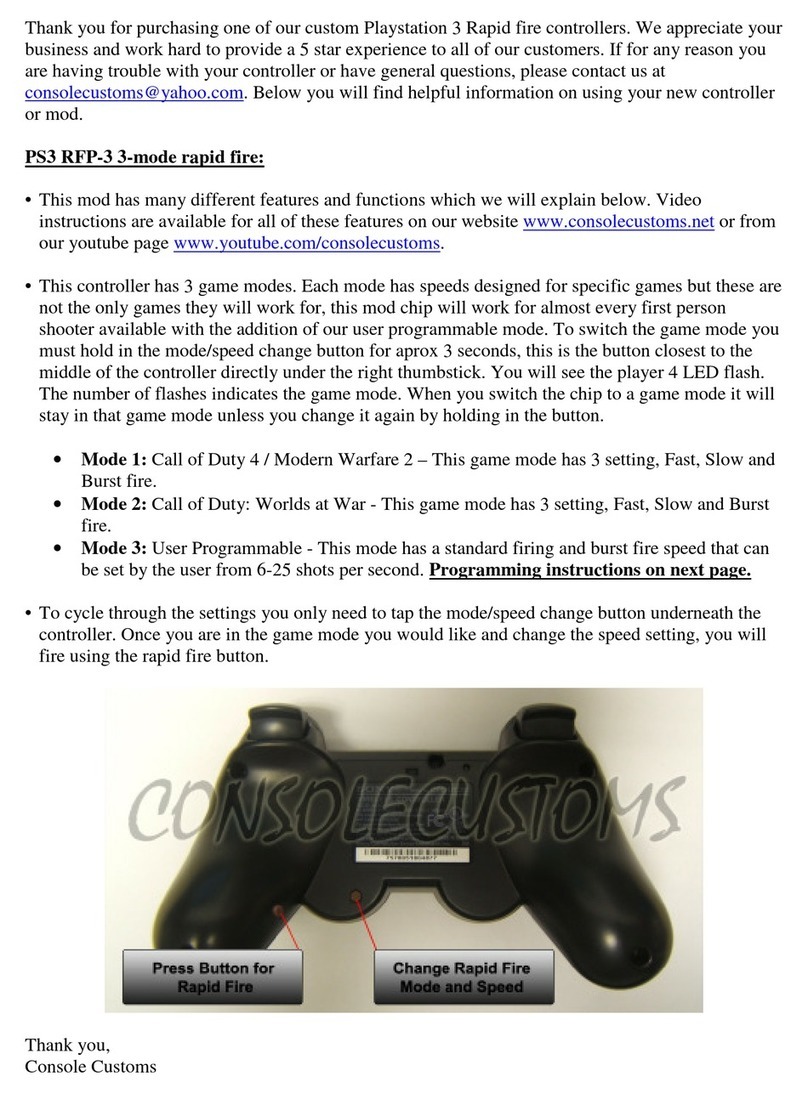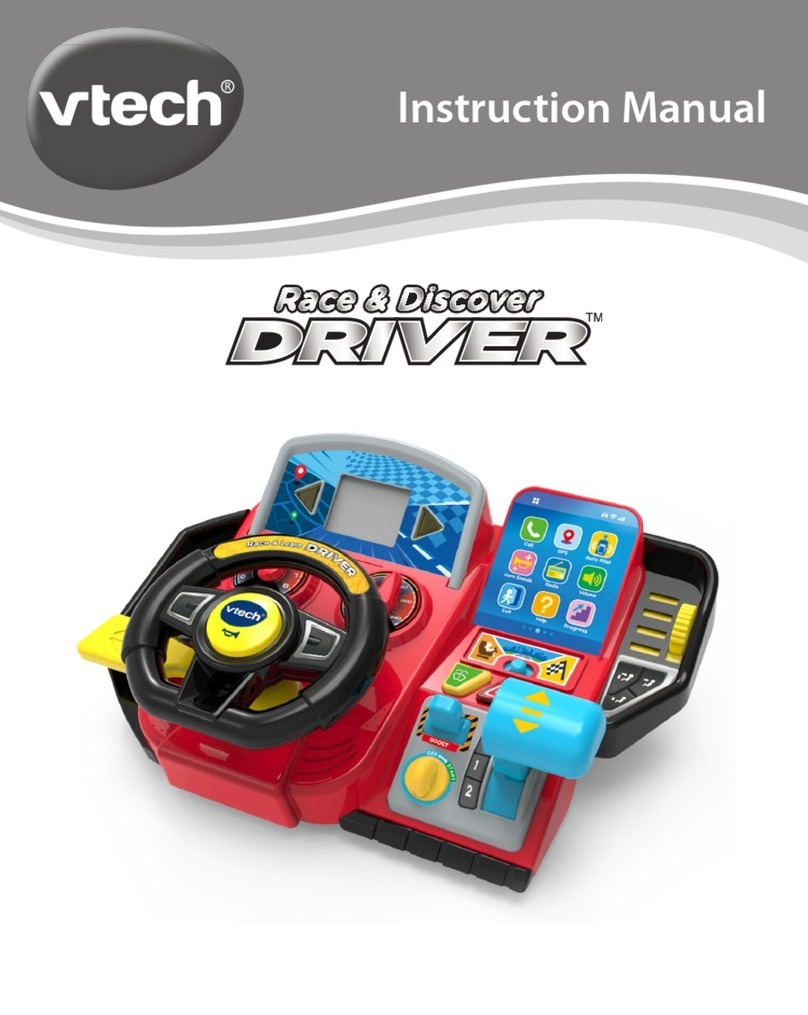GKN Wheel & Rim User guide

Wheel & Rim
Safety Manual

Table of Contents
GKN Wheels Overview ?
The Basics: Safety Warnings, Terminology & Equipment ?
Safety Warnings & General Guidelines ?
Warning about Removal of Air before Servicing Rim Wheel ?
Definitions of Common Terms Used in Servicing Multi & Single Piece Rim Wheels ?
Standard Wheel & Rim Terminology ?
Required Safety Equipment ?
Proper Equipment & Tools for Servicing ?
Safety Procedures & Standards for Servicing Off-Highway Rim Wheels ?
1. Importance of Deflation before Servicing ?
2. Proper Matching of Components before Assembly ?
3. Ensure All Components are in Good Condition ?
4. Preparation of Parts before Assembly ?
5. Safety Precautions during Inflation ?
6. Safety Precautions after Inflation ?
7. Safe Loading ?
8. Safe Installation on Vehicle or Machine ?
9. Safe Operation While on the Vehicle or Machine ?
Mounting & Demounting Specific Off-Highway Rim Wheel Types ?
Multi-Piece Grader & Off-Highway Tubeless Tire Rims ?
Demounting 25”- 49” Diameter Rims with Pry Bar Pockets ?
Demounting 33” & Larger Rims with Continuous Pry Bar Ledge ?
Mounting Tires on Earthmover Rims ?
Oversized Tires on the Vehicle ?
Handling Tubes & Flaps ?
Tubeless Tires on Single Piece 15° Tapered Drop Center Rims ?
Agricultural Rim Wheels ?
15.3” : 9” Width European Rims ?
Rim Wheel Components: Inspection Guidelines ?
Recommended Nut/Bolt Torque Values for Installation ?
GKN Wheels’ Products ?
APPENDICES ?
A. OSHA Standard: 29 CFR Part 1910.177 (Servicing Multi & Single Piece Rim Wheels) ?
B. Mine Safety & Health Administration Regulations ?
C. EUWA Safety & Service Recommendations for Wheels ?
D. Other Sources of Rim Wheel Safety & Servicing Information ?
Identification of Damaged Components ?
Proper Maintenance of Rim Wheel Components ?
GKN Wheels Overview 2
The Basics: Safety Warnings, Terminology & Equipment 3
Safety Warnings & General Guidelines 3
Warning about Removal of Air before Servicing Rim Wheel 4
Definitions of Common Terms Used in Servicing Multi & Single Piece Rim Wheels 5
Standard Wheel & Rim Terminology 6
Required Safety Equipment 11
Proper Equipment & Tools for Servicing 12
Safety Procedures & Standards for Servicing Off-Highway Rim Wheels 14
1. Importance of Deflation before Servicing 15
2. Proper Matching of Components before Assembly 17
3. Ensure All Components are in Good Condition 19
4. Preparation of Parts before Assembly 20
5. Safety Precautions during Inflation 21
6. Safety Precautions after Inflation 25
7. Safe Loading 26
8. Safe Installation on Vehicle or Machine 27
9. Safe Operation While on the Vehicle or Machine 28
Mounting & Demounting Specific Off-Highway Rim Wheel Types 29
Multi-Piece Grader & Off-Highway Tubeless Tire Rims 30
Demounting 25"- 49" Diameter Rims with Pry Bar Pockets 34
Demounting 33" & Larger Rims with Continuous Pry Bar Ledge 36
Mounting Tires on Earthmover Rims 39
Oversized Tires on the Vehicle 42
Handling Tubes & Flaps 49
Tubeless Tires on Single Piece 15° Tapered Drop Center Rims 50
Agricultural Rim Wheels 56
15.3" : 9" Width European Rims 65
Rim Wheel Components: Inspection Guidelines 66
Recommended Nut/Bolt Torque Values for Installation 71
GKN Wheels’ Products 73
APPENDICES 75
A. OSHA Standard: 29 CFR Part 1910.177 (Servicing Multi & Single Piece Rim Wheels) 76
B. Mine Safety & Health Administration Regulations 83
C. EUWA Safety & Service Recommendations for Wheels 86
Identification of Damaged Components 88
Proper Maintenance of Rim Wheel Components 91
D. Other Sources of Rim Wheel Safety & Servicing Information 97

Overview
2 | Wheel & Rim Safety Manual
The extensive product range covers a wide market
sector, including wheels for agricultural tractors,
forage and combine harvesters, trailer loaders, and
lift trucks for the agricultural industry. KN Wheels
also supplies a range of single and multi-piece
wheels for the light and heavy construction
industries, and for use on machines such as
earthmovers, diggers, dumpers, forklift trucks, and
mobile cranes. KN Wheels works in partnership
with global and regional customers to better
understand their key strategic aims. And, wherever
the customer‟s manufacturing facilities, KN Wheels
provides a consistent worldwide customer interface
through the use of account management systems.
At KN Wheels, manufacturing facilities
encompass a proud heritage of wheel making,
backed with multi-million dollar investments in
multi-piece wheel manufacturing facilities,
pressing processes, and painting systems.
New materials, designs, and manufacturing
processes add further value to the supply chain
and contribute to innovative product ranges.
Working in partnerships with universities, industry-
wide bodies, and customers, KN Wheels ensures
its new product introduction programs are always
closely aligned with customers and their specific
needs. New product introduction techniques and
company-wide quality systems ensure products
are delivered on time. Shop floor staff and senior
management share a commitment in support of
KN Wheels’pursuit of business excellence
through lean manufacturing, visual management,
and mission-directed work teams. KN Wheels
supplies a range of components and systems to
industries and applications involved in cultivating
and developing the natural resources and
structures of the Earth’s surface i.e., agriculture,
forestry, construction, and mining.
As an important global partner for its customers,
the division supplies its customers with complete
systems and continues to gear its activities to
further system development.
KN Wheels’manufacturing facilities in the UK, Denmark, Italy, China, and the United
States are equipped to supply a wide range of precisely tailored wheel technologies on
a global basis.

Safety warnings & gerneral guidelines
3 | Wheel & Rim Safety Manual
Improper handling and assembly of off-highway rim wheels can cause serious or fatal accidents.
Components can explode at any time when proper procedures have not been followed, including during:
Mounting & Demounting
Inflation
Installation & Removal
Other Handling or Operation
Always Comply with the Following uidelines:
These guidelines are explained more fully throughout this manual as well as in the OSHA Standards
located in Appendix A.
Proper Training: Never service any tires, wheels, or rims without proper training. For information on
OSHA-recommended employee training and free charts, see OSHA Standards for Servicing Multi- Piece
and Single Piece Rim Wheels, 29 C.F.R.1910.177, which is located in Appendix A.
Tire Servicing Tools & Equipment: Always use the recommended safety equipment and tools.
Proper Wheel Components: Only use clean and matching components that are in good condition. Discard
any worn-out, damaged, excessively rusted, or corroded parts. If you are unsure whether components
match or if you cannot find size markings on the components, do not mount and inflate the tire.
Safe Servicing & Operating Procedures: Learn and follow safe procedures -- every time. Comply with the
proper recommended procedures at all times, including when mounting or demounting, Installing or
removing, inflation or deflation, and any other handling operations. Never take short cuts. If you are
unsure about a procedure, stop and get expert help.
READ, UNDERSTAND, AND FOLLOW THE INSTRUCTIONS IN THIS MANUAL
TO PREVENT INJURIES AND COSTLY DAMAGE.
Safety Warnings are located prominently throughout this manual. Pay close attention to the content of
each warning. This symbol indicates a warning message. Failure to heed warnings could lead to
serious or fatal injury.
WARNING: Air pressure in an inflated off-highway tire mounted on a wheel and rim
creates explosive energy. This pressure can cause the tire/rim components to burst
apart with great force. This is true of both single piece and multi-piece assemblies. If an
exploding tire or rim component or the sudden release of air from a tire strikes you, you
can be seriously or fatally injured. To help avoid accidents, follow all proper procedures
as described in this manual, including OSHA Standards located in Appendix A.

Warning about removal of air before
servicing rim wheel
4 | Wheel & Rim Safety Manual
IMPORTANT! This is the first step in all demounting operations.
For safety’s sake, always remove the valve core and exhaust all air from a single tire and from both tires
of a dual assembly before loosening the first clamp nut.
READ AND FOLLOW THE SAFETY INSTRUCTIONS.
FAILURE TO DO SO COULD RESULT IN SERIOUS OR FATAL INJURY.
For safety‟s sake, always remove the valve core and exhaust all air from a single tire and from both
tires of a dual assembly before loosening the first clamp nut.
WARNING: Check the valve stem by running a piece of wire through the stem to make
sure it is not plugged. If it is necessary to remove the valve core housing, removal
should be done after the valve core is removed and air is exhausted.

Definitions of common terms used in
servicing multi & single piece rim wheels
5 | Wheel & Rim Safety Manual
See OSHA Standards for Servicing Multi-Piece and Single Piece Rim Wheels, 29 C.F.R. 1910.177,
Appendix A.
Barrier: Fence, wall, or other structure or object placed between a single piece rim wheel and an
employee during tire inflation to contain the rim wheel components in the event of the sudden release of
the contained air of the single piece rim wheel.
Demounting a Tire: The disassembly or taking apart of the wheel and tire components to form a rim
wheel, including deflation. The opposite of “mounting.”
Installation of a Rim Wheel: The transfer and attachment of an assembled rim wheel onto a vehicle axle
hub. The opposite of “removal.”
Mounting a Tire: The assembly or putting together of the wheel and tire components to form a rim wheel,
including inflation. The opposite of "demounting.”
Multi-Piece Rim Wheel: The assemblage of a multi-piece wheel with the tire tube and other components.
Multi-Piece Wheel: A vehicle wheel consisting of two or more parts, one of which is a side or locking ring
designed to hold the tire on the wheel by interlocking components when the tire is inflated.
Removal of a Rim Wheel: The detachment of an assembled rim wheel from a vehicle axle hub. The
opposite of “installation.”
Restraining Device: An apparatus such as a cage, rack, assemblage of bars, and other components that
will restrain all rim wheel components during an explosive separation of a multi-piece rim wheel or
during the sudden release of the contained air of a single piece rim wheel.
Rim Manual: A publication containing instructions from the manufacturer or other qualified organization
for correct mounting, demounting, maintenance, and safety precautions peculiar to the type of wheel
being serviced.
Rim Wheel: An assemblage of tire, tube and liner (if appropriate), and wheel components.
Service Area: The area specifically used for the servicing of rim wheels or any other place where an
employee services rim wheels.
Servicing: The mounting and demounting of rim wheels and related activities such as inflating, deflating,
installing, removing, and handling.
Single Piece Rim Wheel: The assemblage of single piece rim wheel with the tire and other components.
Single Piece Wheel: A vehicle wheel consisting of one part, designed to hold the tire on the wheel when
the tire is inflated.
Trajectory: The potential path or route that a rim wheel component may travel during an explosive
separation or the sudden release of the pressurized air. In the case of a single piece rim wheel, the
trajectory is the area at which an airblast may be released. The trajectory may deviate from paths that are
perpendicular to the assembled position of the rim wheel at the time of separation or explosion.
Wheel: The portion of a rim wheel that provides the method of attachment of the assembly to the axle of
a vehicle and also provides the means to contain the inflated portion of the assembly (tire and/or tube).

Standard wheel & rim terminology
Reference SAE Standard J751
6 | Wheel & Rim Safety Manual
Single Piece Rims
1. Nominal Rim Width
2. Nominal Rim Diameter (Bead Seat Diameter)
3. Rim Inside Diameter
4. Valve Hole
5. Flange Height
6. Flange Width
7. Bead Seat Area
Multi-Piece Rims (Three Piece Style)
Single Piece Rims
Reference SAE Standard J751
1. Nominal Rim Width
2. Nominal Rim Diameter (Bead Seat Diameter)
3. Rim Inside Diameter (ID)
4. Valve Hole
5. Flange Height
6. Flange Width
7. Side Flange (Detachable Flange)
8. Lock Ring
9. O-Ring (Rubber)
10. 28 Degree Mounting Angle
11. Lock Ring roove
12. O-Ring roove
13. Rim Driver (Demountable Rim)

7 | Wheel & Rim Safety Manual
Multi-Piece (Five Piece Style)
1. Nominal Rim Width
2. Nominal Rim Diameter
3. Rim Inside Diameter (Id)
4. Valve Hole
5. Flange Height
6. Flange Width
7. Flange (Removable Flange - 2 Required)
8. Lock Ring
9. O-Ring
10. 28 Degree Mounting Angle
11. Lock Ring roove
12. O-Ring roove
13. Rim Driver (Demountable Rim)
14. Bead Seat Band
15. Rim Knurling
16. Pry Bar Pocket

8 | Wheel & Rim Safety Manual
Positive Offset (or Positive Inset)
Offset: The distance between the mounting face of the disk and the rim centerline. (Defined by SAE
standards).
Positive Offset: The distance is termed positive when the mounting face is outboard of the rim centerline.
This is also known as positive inset.
Back Set: The distance between the mounting face and inboard face of the bead seat.
Negative Offset
Negative Offset: The distance is termed negative when the mounting face is inboard of the rim centerline.
This is also known as negative outset.
Back Set: The distance between the mounting face and inboard face of the bead set.
g

Gut ter Pa rt of the Rim Base
Rim Driver
9 | Wheel & Rim Safety Manual
Heavy Duty Loose Key Style
Ri P k t
Driver Lug
Notch in gutter part of the Rim
Lock Ring
Bea d Seat Ba nd Driver P o cket
Heavy Duty Loose Key Style
Multi-Piece Rims – Rim Driver Locks
Lug Style with Notched Gutter
Heavy Duty Loose ey Style
Demountable Rim Driver
Driver Lug
Notch in the Bead Seat Band
Lock Ring
Notch in gutter part of the Rim
Bead Seat Band Driver Pocket
Driver Key
Rim Pocket
28’ Mounting Bevel
Rim Driver
Gutter Part of the Rim Base

10 | Wheel & Rim Safety Manual
Typical heavy duty driver application
2
1. Align driver pockets in bead seat band
and base as shown.
2. Insert driving key into driver pocket
on base.
3. Make certain that all parts are properly
aligned, as shown above, before inflation.
4. View of final assembly.

Required safety equipment
11 | Wheel & Rim Safety Manual
The use of proper tools and safety equipment helps prevent personal injuries and other costly damage.
Remember, an inflated tire contains explosive energy. This can cause the tire/rim components to burst
apart with great force. Protect yourself and others by using the tools and safety equipment
recommended below.
Restraining Device: Always use a safety cage or other
approved restraining device to inflate tires.
A restraining device is the most effective safeguard
against injury that may result from assembly errors.
A safety cage, safety chains, or other OSHA-approved
restraining device is your best protection if there is an
explosion during inflation.
Clip-on Chuck and In-Line Valve and auge: Always use a clip-on air chuck with an in-line valve and
gauge with sufficient length of hose to stand clear from the trajectory.
A clip-on air chuck allows you to keep your hands, arms, and body clear of the trajectory during inflation.
An in-line valve allows you to control the air flow while standing away from the assembly.
An in-line gauge allows you to monitor the air pressure going into the tire while staying clear of
the trajectory.
Safety Cage
WARNING: Facing the side/lock rings against a wall or other permanent structure
during inflation is not safe. If the assembly explodes, you can be struck by flying
components. Fully restrain the rim wheel during inflation of the tire.
100
In-Line Valve and Gauge
Clip-on Air Chuck
WARNING: A hand-held air chuck should never be used to inflate a tire. It is dangerous
because you must put your hand inside the safety cage or the restraining device.
Therefore, you are in the trajectory, which can result in serious or fatal injury.

Proper equipment & tools for servicing
12 | Wheel & Rim Safety Manual
Use only recommended tools and equipment for mounting and demounting off-highway tires and
servicing wheels and rims to achieve optimal safety. Use of proper tools prevents damage to the rim and
components. The use of improper tools or equipment can cause personal injury.
The following tools are required to service the various types of multi-piece rims included in this manual:
The following equipment may be required:
A. Hardwood Blocks
B. Valve Extension Tool
C. Set of Cap and Core Removal Tools
D. Wire Brush
E. Chain or Cable Slings of Adequate Length
F. Bead Lubricant (Non-Petroleum Base)
. Sledge Hammer
H. Rubber Mallet or Equivalent (e.g. Babbitt Hammer)
I. Inflation Hose with Clip-On Chuck, In-line auge and Control Valve.
1. Air-Hydraulic Pump and 50-Ton Jack:
Air supplied to the pump develops hydraulic
pressure to lift the jack. This equipment is
essential in servicing extra-heavy construction
equipment.
2. Air Hydraulic Pump: The pump activates
hydraulic tools, such as the bead breakers and
hydraulic rams.
3. Air Wrenches: Air wrenches and their sockets
are used to tighten and loosen nuts on wheel
assemblies.
4. Bead Breaker: This type of bead breaker is
used for loosening tires from bead seats when
the rim has prying slots.

13 | Wheel & Rim Safety Manual
5. Bead Breaker: This type of bead breaker is
used for loosening tires from bead seats when
the rim has no prying slots.
6. Top: 4” (100 mm) ram
Bottom: 6”-8” (150–200 mm) ram
Ram: A ram is used to apply pressure to the
inside bead flange when removing tires from
5” (125 mm) tapered rims.
7. Mounting Stand: A mounting stand is used
when replacing tires on rims that have been
removed from a vehicle or machine.
8. 11/2-ton Capacity Coffin Hoist: A hoist expands
the beads on tapered bead seats so that the
tire will take air.
9. Service Truck with Hydraulic Hoist: A hoist is
essential for installing and removing heavy
off-the-road tires.
10. Tire Irons: Tire irons pry apart wheel
components.

Safety Procedures & Standards for
Servicing Off-Highway Rim Wheels
14 | Wheel & Rim Safety Manual
1. Importance of Deflation before Servicing
2. Proper Matching of Components before Assembly
3. Ensure All Components are in ood Condition
4. Preparation of Parts before Assembly
5. Safety Precautions during Inflation
6. Safety Precautions after Inflation
7. Safe Loading
8. Safe Installation on Vehicle or Machine
9. Safe Operation While on the Vehicle or Machine

1.Importance of deflation before servicing
15 | Wheel & Rim Safety Manual
Always deflate both tires in a dual assembly completely before removing an assembly from the
vehicle or machine or a tire from a rim wheel. Unseen damage could cause the assembly to explode
during removal if the tire is removed while it is still inflated. See OSHA Standard for Servicing Multi-
Piece and Single Piece Rim Wheels, 29 C.F.R. 1910.177, Appendix A.
Remove the valve core to ensure the tire is completely deflated before loosening any nuts or clamps
or removing the assembly.
Foreign materials may clog the valve stem during deflation or ice may form as air leaves the tire.
Run a piece of heavy wire through the valve stem to make sure that no more air is in the tire and that
debris or other objects have not clogged the valve.
If working on a dual assembly, separately perform each step for each tire.
Never deflate the tire near sparks or open flames.
Run a wire through the valve stem to
ensure tire is completely deflated.
WARNING: Do not add air to tires that have been operated in an underinflated or flat
condition. Adding air can cause the rim wheel to separate explosively. The explosion
can cause serious or fatal injury.
Always deflate, remove from the vehicle or machine, disassemble, and inspect a tire and rim
assembly that has been operated in a run-flat or underinflated condition (80% or less of
recommended pressure). See OSHA Standard for Servicing Multi-Piece and Single Piece Rim Wheels,
29 C.F.R. 1910.177, Appendix A.
Do not stand in front of a rim wheel while deflating the tire. In case of an explosive disassembly, you
need to be out of the trajectory (danger zone).
"Eyeballing" or "thumping" a tire does not provide the pressure reading. Always use an air gauge to
measure tire pressure.

16 | Wheel & Rim Safety Manual
WARNING: Stay out of the trajectory as indicated by shaded area. Always use a safety
cage or other restaining device in compliance with OSHA regulations.
ote: Under some circumstances, the trajectory may deviate from its expected path.

2.Proper matching of components before
assembly
17 | Wheel & Rim Safety Manual
Inspect All Parts for Matching Before Assembly: Rims and rings must match by size and type. Be sure all
the parts of your assembly are matched correctly. Remember: Just because parts arrive together does not
mean they belong together.
WARNING: Mismatched tire and rim components may explode and cause serious or
fatal injury.
The size is stamped on every KN rim base or side/lock ring. The stamping is generally found on the
rim base near the valve slot/valve hole. If you cannot read the stamping on any part, do not use the
part. Such parts should be destroyed and discarded.
Rim components must not be interchanged except as provided for in the OSHA Multi-Piece Rim
Matching Chart. For information on how to get free copies of this chart see SHA Standards for
Servicing Multi-Piece and Single Piece Rim Wheels, 29 C.F.R. 1910.177, Appendix A.
Be sure your tire size is approved for your rim. Wheels and rims may accommodate tires of varying
widths.
Be sure the diameter shown on the tire exactly matches the diameter stamped on the rim base or
side/lock ring. Do not rely on “eyeball” estimates. Even a small difference could result in an accident.
To aid in identifying matching components, KN Armstrong Wheels applies a warning decal to the
tire side of the rim near the valve slot/valve hole on the following rim/wheel diameters:
14.5” 16.1” 16.5” 17.5” 19.5” 22.5” 24.5”

18 | Wheel & Rim Safety Manual
WARNING: There is a danger of serious injury or death if a tire of one bead diameter is
installed on a rim or wheel of a different rim diameter.
Always replace a tire with another tire of exactly the same bead diameter designation
and suffix letters. For example: A 16” tire goes on a 16” rim. Never mount a 16” tire on
a 16.5” tim. A 16.5” tire goes on a 16.5” rim. Never mount a 16.5” tire on a 16” or 16.1”
rim. For the same reason, never mount a 26” rim diameter tire on a 26.5” rim. ever
mount a 30” rim diameter tire on a 30.5” rim.
While it is possible to pass a 16” diameter tire over the lip or flange of a 16.1” or 16.5”
size diameter rim, it cannot be inflated enough to position itself against the rim flange.
If an attempt is made to seat the tire bead by inflating, the tire bead will break with
explosive force and could cause serious injury or death.
Rims if different diameters and tapers cannot be interchanged. The following diagram
illustrates the difference between rims of two different tapers and diameters:
The following diagram shows how beads of a 16” tire will not seat on a 16.5” rim. The
beads cannot be forced out against the rim flanges by using more air pressure because
this will break the beads and the tire will explode with force sufficient to cause serious
injury or death.

19 | Wheel & Rim Safety Manual
Inspect All Parts For Damage: Examine and clean all parts carefully before assembling them. It takes only
a few moments to inspect the rim and side rings/lock rings for problems. Those few moments could save
your life.
Do not use damaged, worn out, or cracked parts. A leak in a tubeless assembly maybe caused by a
cracked rim. Do not try to repair cracked rims. Never put a tube in a tubeless assembly to stop a leak.
Destroy any cracked rim; it could cause an accident.
Wire brush all metal surfaces thoroughly to remove any surface rust or corrosion.
After cleaning, check all metal parts for rust, corrosion, cracks, bent flanges, sprung side/lock rings, and
deep tool marks on rings or in gutter areas. The illustrations below show some of these conditions.
WARNING: Use of damaged parts is very dangerous and is prohibited by the OSHA
Standard for Serv c ng Mult -P ece and S ngle P ece R m Wheels, 29 C.F.R. 910.117.
These parts can fail during inflation, later handling, or while on the vehicle or machine.
You or someone else could be seriously or fatally injured.
Erosion and chipping off bead
seat of lock ring.
Sprung side ring. Cracks through
continuous side ring
spreading laterally
through the entire section.
Cracks in the rim base, in the
back flange and gutter areas.
Deep tool marks on flange
and gutter.
ut of flat rings. ut of round rims. Cracks in rim base.
If you find parts with these or similar problems, destroy them. They cannot be repaired.
For more information see Rim Wheel Components: Inspection uidelines in this manual.
3.Ensure all components are in good
condition
Table of contents
Popular Video Game Controllers manuals by other brands
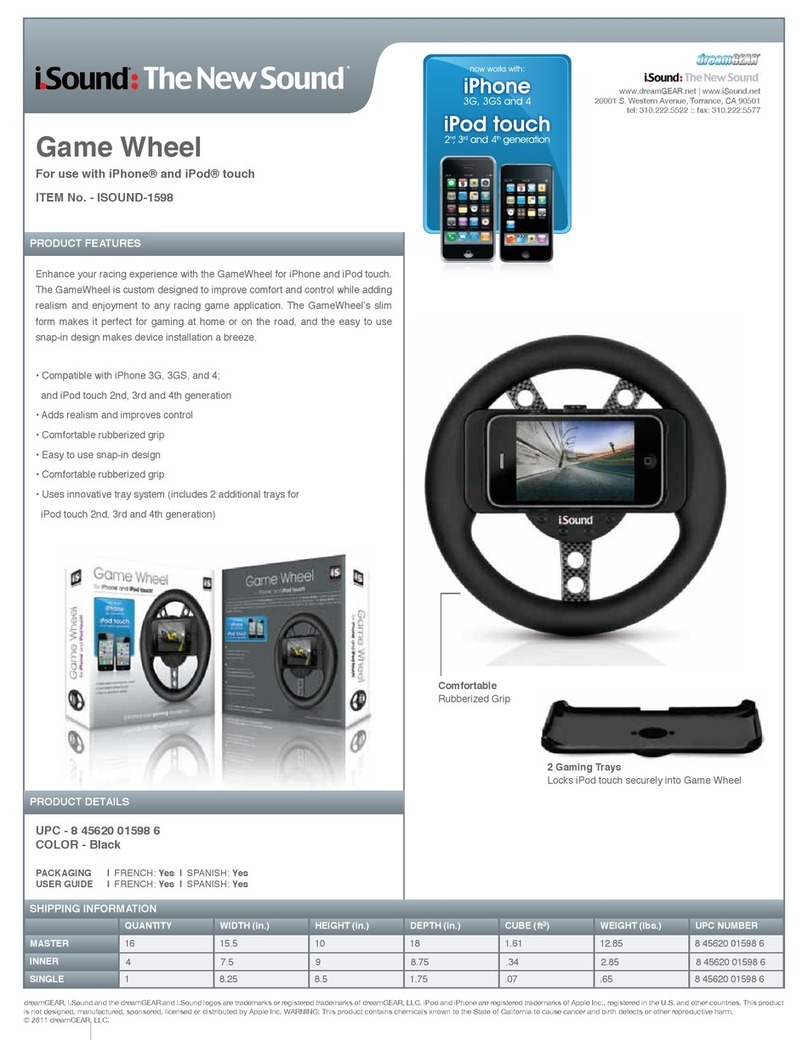
I.SOUND
I.SOUND GAME WHEEL - FOR IPHONE AND IPOD TOUCH datasheet

Hipstreet
Hipstreet GENE SIMMONS AXE manual
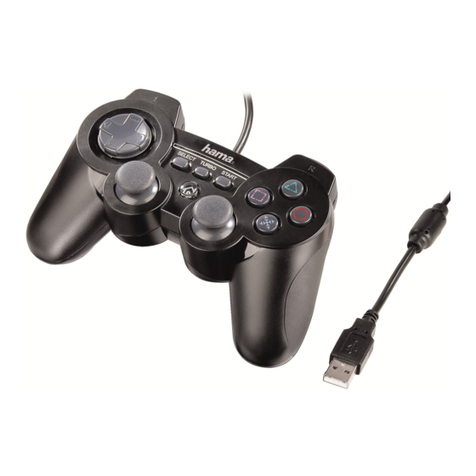
Hama
Hama SCORPAD PRO user manual
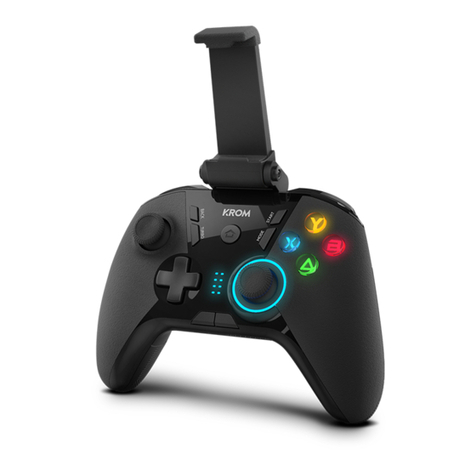
KROM
KROM KLOUD QuickGuide Installation
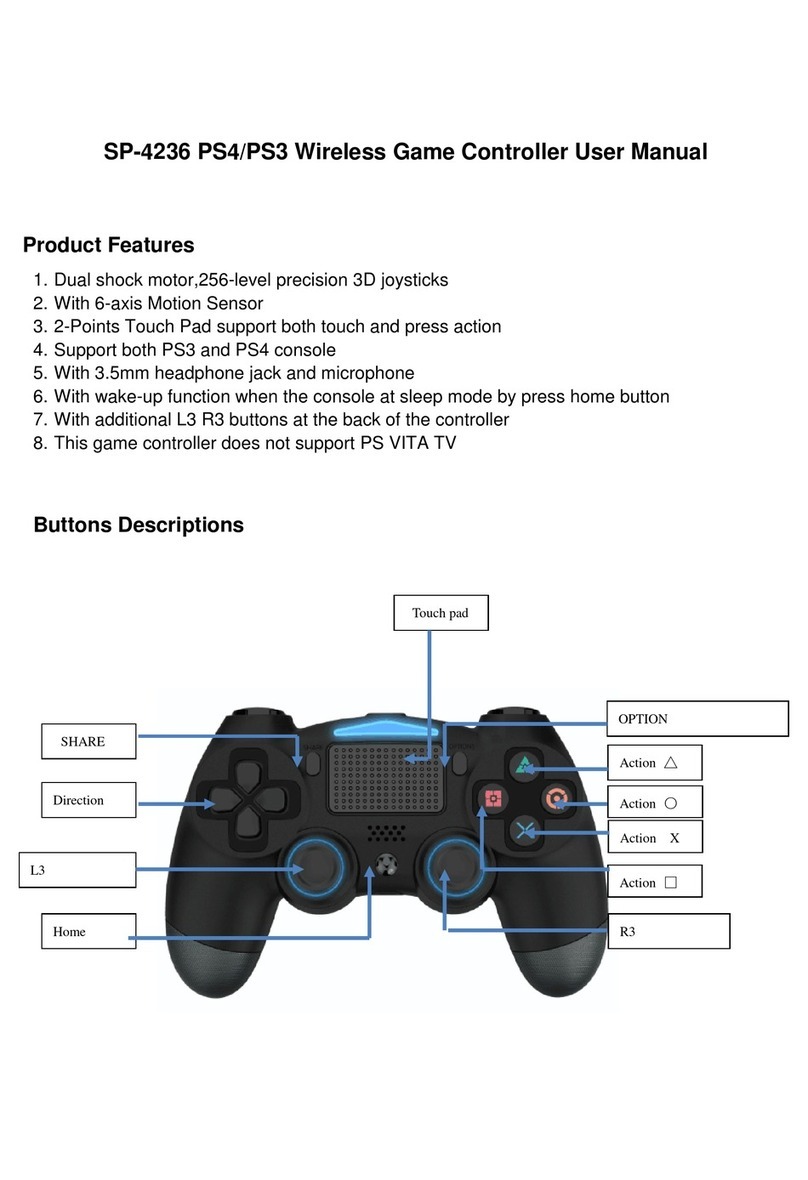
Eastern Times Technology
Eastern Times Technology SP-4236 user manual

Belkin
Belkin n52te - Nostromo SpeedPad Game Pad user manual
